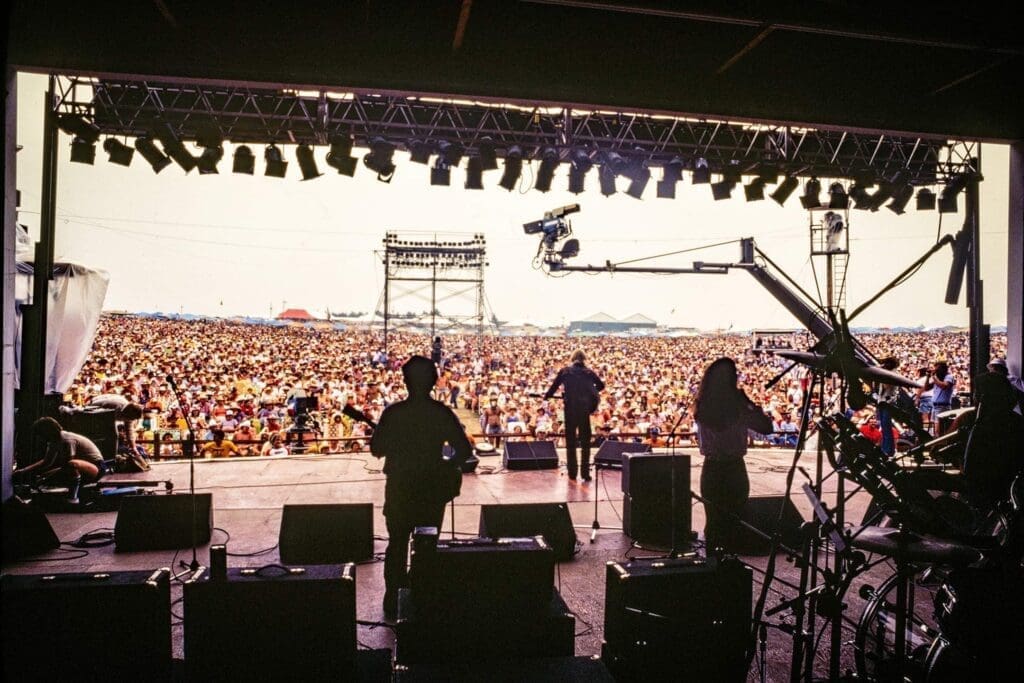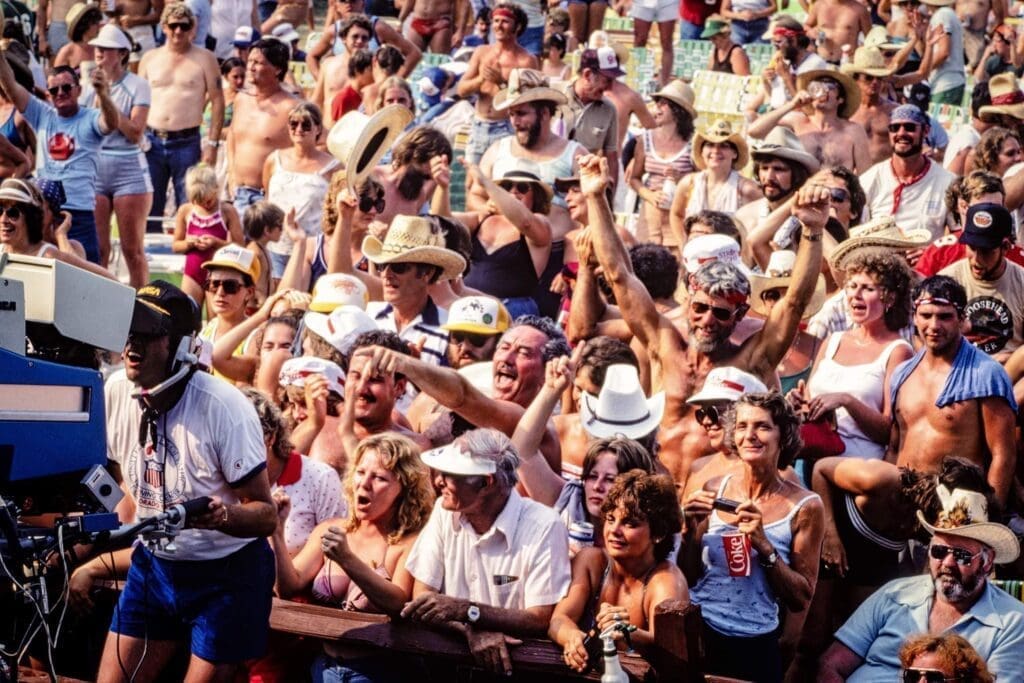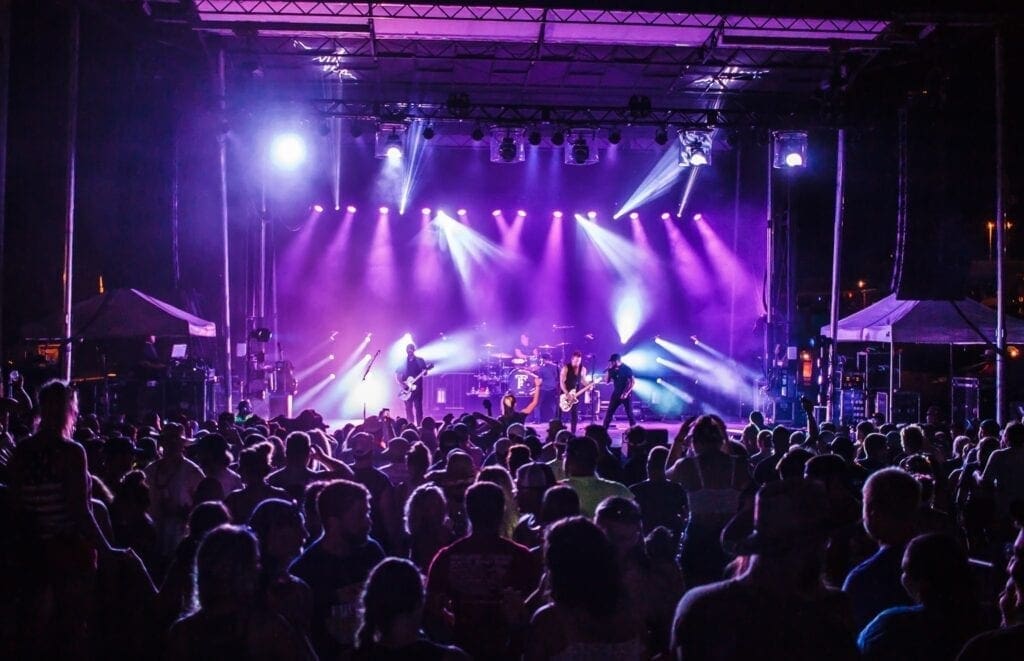(Publisher’s Note: This is the second of two chapters in this series about the history of the legendary Jamboree in the Hills country music festival in Belmont, Ohio. The multi-day event was always scheduled for the third week of July – this week – at two locations in Belmont County, and the four concerts drew more than 30,000 fans to the rolling hills of East Ohio.)
Memory Lane this time of year is a pretty popular path for country music fans in this area of Appalachia. Cooler dancing, wagon dragging, finding folks in Blue B or Green H; well, there’s only one place on Earth where all three of those things could have happened within a five-minute timespan.
Ladies and gentlemen, the Super Bowl of Country Music … Jamboree in the Hills!
Fans planned their summers around it. Locals leased their land for it. Country music stars loved it. People made money on it. An assembled staff produced it, mounted deputies protected it, rain or shine drenched it, and the annual four-day festival provided Belmont County with its biggest economic boost every single year since Schiltz Beer was popular in America.
Schiltz Beer? Well, it was the late 1970s when this shindig began, after all.

There were the early morning “Redneck Runs,” the OVMC medical tents, the squirt bottles, those steak hoagies, Saturday night fireworks, the sunburns, raincoats, reunions, Red Solo cups, campground breakfasts, bikini tops and jean shorts, the banks of Porta Johns, the National Anthem, and Neil McCoy climbing speaker towers on sunny Sunday afternoons.
And yes, there was much more that defined it, and that’s why, at this time of year – especially during this third week of July – the “Jambo Blues” are very real.
“I think about Jamboree in the Hills a lot, especially when the weather gets warmer, and when July comes around, I miss it because that’s when our own team started to come together, and that was our own reunion. That was special to us,” recalled Kelly Tucker, the general manager of the four-day festival at the end. “That weekend in July will always be my favorite weekend of the year.
“When this time of year comes around, I can’t help but think about all of those people, the stars and the music, and the fans. There were issues, trust me, but the majority appreciated what we did for them. There was a lot of happiness and a lot of hugs,” she explained. “Putting on that show, with everything involved, was something we were all very proud of. I may have been the general manager, but that week happened thanks to a lot of people who were the best at what they do.”

The crowds always were the biggest you’d ever seen with your own two eyes, and some Jamboree weekends were bigger than others because headliners like Garth Brooks started achieving new-level, mega-star status. That’s why, in fact, the only year Brooks performed in Belmont was in 1990.
It was because the music industry changed over the years, and instead of the singer/songwriters profiting from album sales, the fees for mainstream performers began skyrocketing at the turn of the century thanks to something called the Internet and digital music.
“I believe Jamboree in the Hills changed as country music changed, and there have been a lot of changes through the years,” explained Chris Dutton, co-founder of the Blame My Roots County Music Festival who worked for his family’s Valley View Campground during the JITH era. “Country music goes through a style change every 10 years or so, and there’s one taking place right now. With those changes come different artists with new shows, so the people with the Jamboree had to adjust for better and worse.

“We saw country music become much more popular in the early 2000s, and we saw a jump in attendance at the campgrounds. Our camper population doubled at one point in the matter of a couple of years in the early 2000s, and it was because of what was taking place in the country music industry,” he explained. “Everything got younger, and the party got bigger, believe it or not.”
The Fine Day Campround also was located just west of Jambo’s Gate A and that yard drew a jam-packed crowd of Jamboree fans, too. That’s why Dutton has clear memories of literal parades of people walking (or at least trying to) along National Road to and from the concerts.
“There was security and crowd control, trust me. It became more important than ever during the early 2000s,” Dutton said. “There were more than 7,000 campers on our family’s farm during those bigger years.
“Safety was huge with us, and I know it was really important with the people who ran the Jamboree,” he said. “It was then when there were a lot more up-and-comers on the schedule and then there would be a superstar at the end of the show, and that was because of the performance fees. It’s still pretty crazy in the country music industry and the competition is impossible for an independent festival. That’s why we retired Blame My Roots.”

Black Bleeds Red
They tried “Jambo County”.
It was to be a shorter event, no coolers of beer would be permitted inside the venue, and the lineup would be good but not great.
It all meant that, finally, the economics connected to coolers of beer instead of lines to buy beer caught up with the free-for-all blessing that was Jamboree in the Hills, and fans were enraged and wanted blood. Tucker, a young lady born into the Jamboree business thanks to her late mother, Kathy, had to hide from death threats.
“That was a horrible experience,” she said. “I’m just glad (Live Nation) scrapped that plan pretty quickly.”
After two more years, though, the next plan that came from Live Nation brass was a “gone-for-good” plan pronounced “Hiatus.”
Tucker had no warning. The phone rang, and that was that.

“We lost Jamboree in the Hills because the business model no longer worked,” she recounted. “That’s the real answer. The artist fees climbed too high and the only money we were really making was from the ticket sales, and it wasn’t enough to pay for what we had to pay for.
“And yeah, we were still letting the fans bring their own coolers in, and that didn’t help but it was part of what the festival was all about. When changes were announced (for Jambo Country), the fan reaction was pretty harsh. But it really came down to the fact the entertainment cost too much for Jamboree in the Hills to continue the way it was. So, the decision was made.”
The Duttons presented Blame My Roots for four years, and now the Old Washington Music Festival is scheduled for this Thursday through Sunday afternoon. The event will be held at the Guernsey County Fairgrounds, artists Travis Tritt, The Marshall Tucker Band, Colin Raye, and Craig Morgan will lead a lineup of country music performers, and tickets can be purchased by calling 615-946-4697.
Coolers are welcome inside the show, on-site camping is available, and the weekend is all about America and country music.
Sound familiar?
But can anything similar to IT be the same as IT?

“My answer is no, I don’t think Jamboree in the Hills could ever be duplicated, and that’s because of the people that made it part of their lives every single year,” said Tucker, who is now the executive director of Wesbanco Arena and the Capitol Theatre. “Country concerts are huge these days, so the industry is very strong, but I remember when someone from Live Nation came to Jamboree one year and they told me the company needed to do the same festival all over the country. All I could do was laugh.
“They asked me if I thought the company could do it and my answer was ‘No’ because Jamboree in the Hills wasn’t something anyone could recreate somewhere else. I knew they wouldn’t like my answer, but there was no way we could recreate what this festival meant to the fans and to the people who worked it. That’s what made it work. The people were the heart of it, plain and simple.”
The “hiatus,” obviously, turned out to be a permanent pause, and these days the legendary land is utilized as staging areas for gas and oil operations in Belmont County. The classic red barn still can be seen by motorist traveling U.S. 40, and some of the old, faded signage still hangs like grave markers in unkept, forgotten cemeteries.

Some say they still hear the echoes while others excuse the sounds as wishful daydreaming.
“We lost the spectacle that was Jamboree in the Hills. We lost big country music. We lost the big, multi-day show in the massive venue,” said Dutton, who now works with the operations of the Pike 40 Restaurant and the Dutton Cattle Co. “We lost our tradition. What Jamboree in the Hills was didn’t exist before it. We knew when we started Blame My Roots that it was never going to be what Jamboree was. We did believe we could provide a version of it, but the industry had changed too much for that to happen.
“We lost something we’ll never forget. We lost that hallowed ground. We lost those reunions that took place in Red C or Green B. We lost something that can never be duplicated ever. That’s what we lost,” he added. “We lost that weekend on that hillside. Yeah … we lost our big spectacle in our own backyard.”


